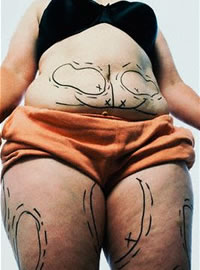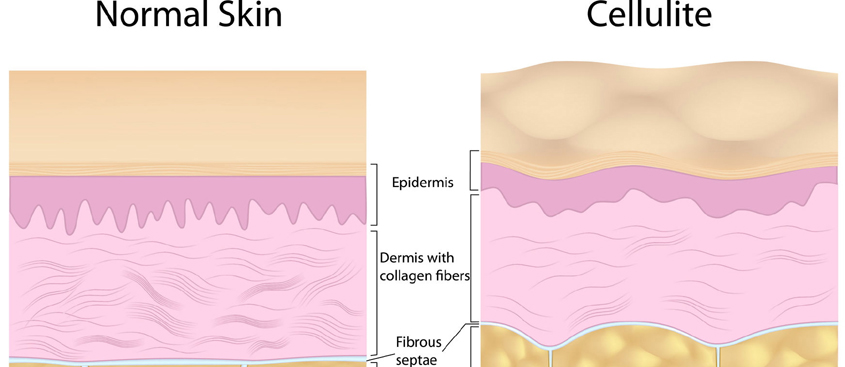The word “Cellulite” which is not a medical term was coined in European spas and salons in the early 1970’s to describe deposits of lumpy, pitting or dimpled fat commonly affecting the thighs, buttocks and hips as well as the abdomen and breasts of most women and some men. This is much more common in women because of the way connective tissue, fat and muscle are distributed in the skin. 90% of women over the age of 20 have cellulite and female hormones like oestrogen contribute to this fat distribution. Weight gain and genetic predisposition are also contributing factors. These cause an increase in subcutaneous fat cell size (up to 300 times) in the network of fibres that holds the cells together. The fat cells stick together in enclosed pockets that bulge upward straining the fibres in between and inhibiting circulation thus trapping water and toxins. This gives rise to the lumpy, bumpy, orange peel, cottage-cheese-like appearance of the skin overlying affected areas.
Cellulite is not a fat problem as even the thinnest of women may be afflicted. It is caused by reduced circulation and lax connective tissue and this explains why diet and exercise alone have little or no effect. Poor circulation results in the slowing down of the cleansing process causing toxins and waste products to accumulate that harden into immovable pockets of fat leading to the dimpled effect. Cellulite can range from feeling hard and cold to feeling spongy and doughy. Treatment is aimed at improving circulation and strengthening connective tissue by boosting collagen production in addition to diet and exercise.
Can you pass the cellulite pinch test? I think not. Pinch the skin of your thigh between your thumb and index finger and tell me what you see……… The orange peel appearance is Cellulite! There are different degrees and it gets worse with age. The upside is that it is not an illness and there are a lot of treatment options available that considerably improve the appearance of cellulite.
Most people want the smoothest bodies possible and don’t like lumps and bumps while others can’t be bothered. There are people who think the dimpling is cute! It’s all a matter of opinion and how you visualise “perfection”. As they say, “Beauty lies in the eyes of the beholder”. For those of us that want to be smooth all over, here are some remedies tried and tested.
Banish the “Blubber Butt”!!
You are What You Eat
What you eat has a major role to play as a diet with excessive sugar and fat that lacks essential nutrients, antioxidant vitamins in particular (Vitamins C and E) and trace minerals, leads to premature degradation of supportive collagen in the Dermis. This encourages an increase in fat cell size that pulls down on the Epidermis, creating the dimples. Some chemicals in junk food mimic the female hormone, oestrogen, compounding the role this hormone plays in cellulite formation.
Cut down on sugar, fat and refined carbohydrates. Increase your protein intake and take nutritional supplements containing essential vitamins (Vitamins C and E at 1g to 6g and 400IU daily, respectively) and trace minerals.
- Eat organic fresh food and avoid processed food loaded with preservatives and chemicals.
- Reduce your intake of dairy products especially cow’s milk.
- Hydrate yourself by drinking lots of still water and avoid diet pills and diuretics.
Exercise
An active lifestyle is important. Sitting all day long puts pressure on the epidermis, and makes cellulite worse. Regular exercise boosts circulation and is essential for overall wellbeing. I recommend a combination of aerobics, stretching and toning exercises at least three times a week.
Body Brushing
Body Brushing can be done in the bath using a bath brush, loofah or sisal sponge. This improves skin texture and boosts circulation. Brush before your bath and make sure the brush is not too hard to avoid scratching the skin (if bristles are too soft it won’t be effective). Start from your feet and brush up your legs and across your hips, bottom and abdomen in long upward strokes then from the hands towards the shoulders working towards the heart. This promotes lymphatic drainage to help detoxify affected regions. If you find this uncomfortable or have sensitive skin, wet your brush or sponge and use it in the shower or bath. Don’t scrub too hard as you can damage tiny skin capillaries.
Massage
Deep mechanical massage helps improve the appearance of cellulite. This could be done at home or professionally. There are a variety of massage tools with wooden or rubber heads as well as motorised versions that are available for home use. Some spas offer Japanese cellulite treatment massages that involve brisk body brushing with plant based bristle brushes. As earlier mentioned, this leads to an increase in blood flow and lymphatic drainage that removes toxins and improves cellulite. Body wraps and scrubs also achieve these results.
Endermologie
Endermologie is a non-surgical technique developed in France more than a decade ago and is reputed to be one of the most effective methods used for improving the appearance of cellulite. It offers a deep stimulating tissue massage and the machine has a high-powered, handheld massage tool made up of a treatment head and two motorised rollers with a suction device that compresses the affected tissue between the two rollers. This gentle suction massages the skin, improves circulation and stimulates the subcutaneous and deep layers of fat and muscle. It also stimulates the connective tissue, promotes collagen production and exfoliates the skin, enhancing its appearance. An average of ten sessions is required with monthly maintenance treatments thereafter.
Cellulite Creams
There are creams that also help improve the appearance of cellulite. They can be categorized into those that boost collagen production such as Cellex-C Body Smoothing Lotion (it contains L-Ascorbic acid) that stimulates fibroblast activity in the Dermis and a myriad of Cellulite creams that in addition may contain substances ranging from theophylline, caffeine and herbal extracts that temporarily plump up the skin and stimulate the breakdown of fat giving it a smoother appearance. Some people even scrub affected areas with ground coffee beans to maintain smoothness.
Cellulite Treatment Undergarments
Cellulite treatment undergarments have become very popular among European women. Usually in the form of tights, they contain microscopic capsules of caffeine, theophylline or natural minerals that release the ingredients slowly into the skin in response to body heat and stimulate the breakdown of fatty tissue by speeding up metabolism.
To get the best results, combine diet and exercise with massage therapy and cellulite creams. As with all good treatments, patience and consistency are required







Hey i’m for the first time here. I came across this blog and I find It really helpful & it helped me out a lot. I am hoping to give something back and help others like you helped me.
I am 48 years old & have lost 102 within the last eight years. So needless to say I have very old saggy skin. I have tried many topical treatments over the years to tighten my skin & also have worked out with weights and a personal trainer for years. So far the saggy skin remains. I have been using Dermal MD anti cellulite serum for about a week now. It does make your skin really soft. I put it on in the shower & just do a light towel dry and apply the oil. I also keep a wet wash cloth in the shower in case I get too dry😍😍